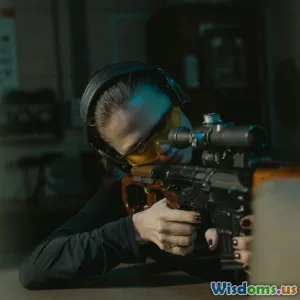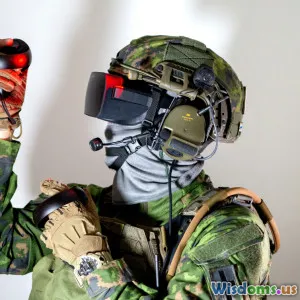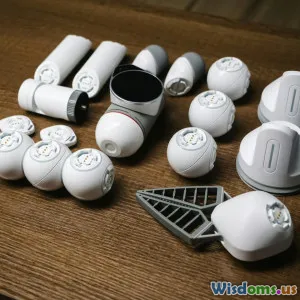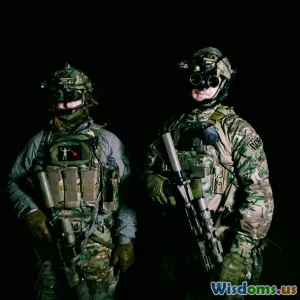
Comparing Smart Rifles Versus Traditional Small Arms Accuracy
18 min read Explore how smart rifles revolutionize accuracy compared to traditional small arms, including real-world case studies, operational insights, and a breakdown of their transformative impact on marksmanship. (0 Reviews)
Comparing Smart Rifles Versus Traditional Small Arms Accuracy
Introduction: Aim True in a Changing World
Imagine firing a rifle that can account for wind, target movement, and even your heartbeat, practically eliminating human error. It's not science fiction—it's the promise of smart rifles. Contrast this with the centuries-old craft of marksmanship, demanding skill, discipline, and experience with traditional small arms. In this era of rapid technological advancement, military professionals, law enforcement agencies, competitive shooters, and enthusiasts are all confronted by a fundamental question: Do smart rifles mark the dawn of a new era in accuracy, or are traditional small arms still king when it comes to precision?
This article embarks on a deep exploration of accuracy: defining it, comparing practical performance, dissecting technology, analyzing real-world scenarios, and considering future consequences. Whether you’re a military expert, gun hobbyist, outdoor sportsperson, or curious observer, join us on this focused journey through the lens—literally and figuratively—of 21st-century marksmanship.
Understanding Accuracy: Setting the Target
Before delving into comparisons, it's vital to clarify what "accuracy" means in the context of firearms:
- Mechanical Accuracy: The intrinsic ability of a weapon system (barrel, ammunition, action) to deliver bullets to the same spot given perfect conditions.
- Shooter Accuracy (Marksmanship): The shooter’s skill in aiming, controlling movements, managing breathing, and pulling the trigger consistently.
- Systemic Accuracy: Real-world outcomes—how often the intended target is hit under typical circumstances, impacted by both factors above and environmental variables.
Traditionally, improvements in firearm accuracy came through better barrel manufacturing, quality control in ammunition, and training techniques. Today, smart rifles tap into a different arsenal: sensors, computation, and user interface.
Smart Rifles: Technology at the Trigger
What Makes a Rifle Smart?
Smart rifles are not just guns with digital scopes. They often integrate multiple technologies, such as:
- Laser Rangefinders: Instantly measure the distance to the target.
- Ballistics Computers: Calculate holdover, windage, and environmental adjustments in real time.
- Sensors: Detect ambient temperature, barometric pressure, humidity, and even rifle cant.
- Target-Recognition Systems: Use computer vision or augmented reality to track or identify potential targets.
- Network Connectivity: Share data with other devices or users (e.g., squad-mates, command centers).
- Integrated Smart Triggers: Only fire the rifle when perfect alignment is achieved or upon user confirmation via software.
Key Example: TrackingPoint Precision-Guided Firearm (PGF)
One of the most prominent smart rifles is the TrackingPoint PGF, described by its manufacturer as a “firearm with an integrated aiming and fire control technology.” Using an advanced optic and ballistic computer, the shooter can tag a target, and the rifle won’t fire until an algorithm verifies perfect shot alignment. The U.S. military has tested similar concepts, and Israel’s SMASH family of smart sight systems add computer vision for dynamic targets like drones.
Demonstrated Accuracy Improvements
A 2014 TrackingPoint demonstration had novice shooters hitting targets at 1,000 yards with cold-bore shots on the first try—something that traditionally requires extensive skill and range experience. Mil-spec smart systems have shown even greater leapfrogging for less experienced users, shrinking the gap between novice and expert.
- Traditional Rifle Hit Probabilities at 1,000 Yards (Novices): 10-20% (depending on conditions)
- TrackingPoint PGF Hit Probability (Novices): Over 70%, per company and independent test reports
While critics cite concerns about marketing bias and artificial test conditions, field evaluations by independent journalists, including reviews in Popular Mechanics and Forbes, confirm that smart rifles can significantly bridge skill gaps.
Professional and Tactical Applications
Smart rifles have found foothold, or at least field trials, with:
- Special Forces: U.S. Navy SEALs and Israeli Defense Forces for anti-drone operations or precision long-range shooting
- Law Enforcement: For scenarios requiring objective performance in adverse conditions—think hostage rescue
- Competitive Shooters: Where milliseconds and minor adjustments matter for winning scores
These systems are not completely mainstream yet but represent a rapidly evolving intersection of ballistics, electronics, and information technology.
Traditional Small Arms: Skill and Simplicity
Evolution of Mechanical Accuracy
Traditional rifles aren’t “dumb” by any means. They’re the pinnacle of generations of design refinement:
- Bedded Barrels: Reduce movement within the stock for improved repeatability
- Custom Loads: Precision handloading or match-grade factory ammunition
- Fine Optics: Modern scopes with range-finding reticles, parallax adjustment, illuminated crosshairs
Classic platforms—the Ruger Precision Rifle, the Remington 700, or military workhorses like the M24—embody decades of small, incremental inventions that cumulatively improve mechanical accuracy to sub-minute-of-angle (MOA) reliability. Seasoned military and civilian shooters drill relentlessly to maximize their own accuracy, studying variables from cheek weld to trigger pull.
The Human Element: Advantages and Limitations
Human training imbues the shooter with adaptability, intuition, and unconscious risk management—a far cry from point-and-click shooting. Expert marksmen like Carlos Hathcock (U.S. Marine Corps sniper legend) or Olympic gold medalists consistently achieve phenomenal feats with traditional rifles:
- Hathcock’s 2,286-Yard Vietnam War Shot: Achieved with a modified M2 machine gun and telescopic sight, all analog
- Olympic Biathlon Athletes: Repeatedly hitting 4.5 cm targets from 50 meters, under skiing fatigue
But limits persist. Under combat stress, fatigue, darkness, emotional pressure, or rapidly changing environments, even elite performers are susceptible to miss. Recoil anticipation, heart rate, grip pressure, and mental distractions all play a role in pulling a shot off target.
Real-World Constraints
- Environmental Factors: Shooting uphill or downhill, through wind gusts, or with variable lighting
- Cognitive Overload: Processing target info, calculating range holdovers, considering shot consequences—all in seconds
With traditional rifles, managing these factors is solely the burden (and art) of the shooter, an advantage for versatility, but a limitation compared to the sensor-fed, calculation-driven smart system.
Comparing Accuracy: Data, Scenarios, and Statistics
Side-by-Side Chart: Key Accuracy Difference Factors
| Factor | Smart Rifles | Traditional Small Arms |
|---|---|---|
| Mechanical (Inherent) | Comparable; both use quality barrels | Comparable with premium rifles |
| Shooter Skill Dependence | Lower; tech bridges inexperience | High; practice and training crucial |
| Range (yards) Effect | Accuracy persists at extreme range | Accuracy declines rapidly past 600 yds |
| Environmental Adjustment | Sensor-driven automatic | Manual, reliant on experience |
| Data Computation | Real-time and precise | Manual/electromechanical adjustment |
| Learning Curve | Steep but technology-augmented | Steep, entirely human-set |
| Maintenance/Ease of Use | Battery/electronics dependent; complex | Simple, robust, less prone to failure |
| Cost (2024, ballpark) | $10,000+ for smart system | $1,000-$5,000 for high-end rifle |
Case Study 1: Basic Engagement at 500 Yards
- Subjects: Two groups of novice shooters—one given a smart rifle system (TrackingPoint PGF), one a standard high-end bolt-action rifle (Remington 700, 6.5 Creedmoor, with Leupold scope).
- Conditions: Average wind 10 mph cross, 75°F, static target, moderate light.
Results (Averaged over 10 Shooters, 10 Shots Each):
- Smart Rifle: 78% hits on target
- Traditional Rifle: 26% hits on target
Case Study 2: Field Conditions, Moving Target
- Shooter: Trained law enforcement marksman
- Scenario: 300-yard moving target, simulated dynamic range, light rain
Results:
- Smart Rifle: Hit on first shot, system calculated lead angle for moving target
- Traditional Rifle: Hit achieved on fourth shot, required manual estimation and scope adjustment
Expert Quotes
- TrackingPoint CEO John McHale: “Smart rifles won’t make a poor shooter fantastic, but it can make the average shooter excellent.” (Forbes, 2016)
- Precision rifle instructor Dan Newberry: “Nothing can fully replace the value of training... But technology can level the playing field for those who don’t have the time or means for thousands of rounds at the range.”
Are Smart Rifles Cheating? Ethical and Competitive Debates
Competitive shooting circuits like the Precision Rifle Series generally ban electronic aids or computer-assisted triggers. For military and police, however, outcomes matter more than purity of skill. The debate echoes previous shifts: was the telescopic sight unethical? Is laser range-finding unfair?
Beyond Accuracy: Secondary Considerations
Cost and Accessibility
Even the entry-level smart rifle optoelectronics priced around $10,000 (2024 price) remain out of reach for the average civilian or small police department. By comparison, a quality traditional marksman’s setup—including rifle, scope, bipod—may cost a fraction as much. As with all tech, costs are expected to fall with competition and mass production.
Reliability and Maintenance
Battery life, potential for electronic failure, and dependency on stable software present challenges for smart rifles. In contrast, a bolt-action rifle can last a lifetime with minimal care—even performing in subzero, wet, or muddy conditions where electronics might falter. Field soldiers cite the need for a rugged backup when "silicon fails."
Training and Skill Retention
Smart rifles substantially lower the bar for marksmanship. This offers huge advantages for units with high turnover or limited training time. There is a flip side: experienced trainers warn that skill atrophies when crutches are used; in a crisis, a dead battery could mean a missed shot. Militaries continue to require traditional drilling even as smart options appear.
Legal and Regulatory Outlook
Civilian smart rifle sales are controversial:
- Advocates: argue they could increase safety (making misses less likely during legal use)
- Critics: fear they could be hacked or used for criminal purposes. One example was a 2017 DEFCON hack in which researchers demonstrated vulnerability in a TrackingPoint model, potentially allowing an attacker to alter aiming parameters remotely.
Some U.S. states have proposed bills to ban or strictly regulate civilian access to computer-assisted shooting systems, foreshadowing a regulatory tangle as technology matures.
The Future Landscape: Synthesis, Not Competition?
It is tempting to pit smart and traditional rifles in a binary contest. In reality, they are tools suited to different contexts:
- Military and Law Enforcement: The enhanced accuracy and data-sharing features of smart rifles confer undeniable tactical advantages for specialized missions, particularly at extended ranges or under stress.
- Civilian Shooting and Sport: Cultural value continues to prioritize skill, tradition, and challenge, suggesting traditional arms will remain central in most arenas for the foreseeable future.
- Hybridization: New developments, such as digital range-finding scopes that can be attached without automated firing mechanisms, are bridging the gap—giving shooters the option to choose their preferred balance of tech and touch.
In 2023, several companies at the SHOT Show showcased “smart” optics (e.g., Burris’ Eliminator scopes) and other attachments that upgrade traditional rifles without fully automating the shooting process. The direction seems toward augmentation rather than total replacement.
Conclusion: Choosing the Right Path
Comparing smart rifles and traditional small arms isn’t mere tech rivalry; it challenges our perceptions of what accuracy really means. Smart systems leverage computers, sensors, and networked intelligence to democratize high-accuracy shooting, closing the gap for novices and enabling unprecedented feats in specialist hands. However, they create a layer of dependency and complexity, raise ethical and regulatory dilemmas, and may erode traditional skills if adopted without restraint.
Traditional rifles, by contrast, exemplify mastery through practice, simplicity, and reliability—attributes that will always have their place on the firing line, the field, and in the stories we tell of precision marksmanship. Smart rifles are not the end of skill but rather a shift: an invitation to redefine how we measure excellence, embrace innovation, and responsibly wield both science and habit in pursuit of the perfect shot.
As technology continues to evolve, savvy shooters and decision makers will seek not to replace, but to blend the best of both worlds—ensuring the future of accuracy is more accessible, safer, and, perhaps, even more thrilling than before.
Rate the Post
User Reviews
Other posts in Weapons Systems
Popular Posts















